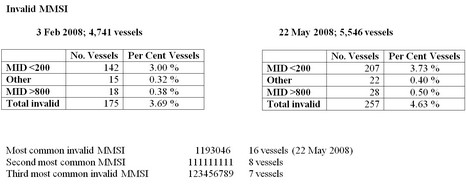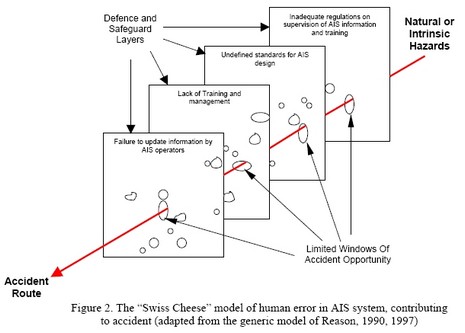Invalid MMSI numbers, a real problem

The above (bigger here) is clipped from an interesting report on MMSI “anomalies” that dropped into my e-mail box. It makes a good case for why the FCC decided that Class B AIS devices should have their MMSI numbers input in a controlled way, and why, as noted in the new Report and Order (page 20), it may extent those controls to Class A. As I understand it, invalid MMSIs don’t affect AIS’s primary collision avoidance function—unless there are duplicates in the same target area—but they can mess up advanced functions like DSC calling (and security monitoring). Here’s more detail on the report:
* Twice in the last year a U.S. Coast Guard system called NAIS (National Automatic Identification System) was used to “collect 30 to 40 million position reports from approximately 5000 AIS-equipped vessels off the US coast and in US waters during a 24 hour period.” (NAIS must have a pretty good receiver network!)
* The MMSI numbers were analyzed and, as you can see above, 3.7% were found to be invalid on one of the test days, 4.6% on the other. Specifically 4.2% were found to have an illegal MID, which is the three digit country ID that begins each ship’s MMSI, and which are only supposed to run from 200 to 800. (Here’s a USCG MMSI explanation, and here’s an ITU list of assigned MIDs.)
* The most common invalid MMSI was 1193046, which is the default of older Nauticast A units, and a problem noted here by commenter “deckofficer” on the 22nd. I know ACR/Nauticast is working on this, but it’s hard to fix electronics that are usually roaming the oceans.
* Interestingly, the primary purpose of this testing was not to find invalid MMSIs but to see if NAIS could use the GPS “Sync State” included in AIS messages to monitor for areas of GPS system interference or anomalies (kind of like GPS cell phones monitoring traffic). I don’t know the results, but if it works it would be yet another good use for the AIS system.
PS A study by Abbas Harati-Mokhtari—AIS: A Human Factors Approach (PDF here)—documents more static data errors, MMSIs included, and illustrate the “Swiss Cheese” model of potential accidents:















Ben,
The Furuno FA50 Class B AIS Transponder is a Black Box design. It has both a standard serial output interface and an Ethernet Interface Port as well. It is interesting that the FA50 has a built-in Web Server for programming the vessel’s MMSI and Static Data.
To program the FA50, you simply plug in an Ethernet Cable to your PC and open Internet Explorer. Browsing the IP Address of the FA50 will bring up the programming pages which are very clear and straight forward. Because there is no software to load and the information is detailed on the PC screen, it should reduce the false MMSI Problems. The system will also not transmit until the MMSI is entered.
Furuno Tech
{Editor note: I can not confirm that this commenter really is from Furuno, but I hope so!}
Interesting data!
Since these were presumably all Class A devices, being used in order to comply with statutory requirements, it would seem that there are at least hundreds, if not thousands, of ships in violation of the law (i.e. did they cover all US waters during the sample?).
I assume the CG has the mandate to enforce the requirement of an AIS unit for selected commercial vessels. Might be interesting to see if they have any official policy or statement on AIS enforcement.
It would be nice if they would allocate some test numbers that could be used for MMSI for workshop testing, etc.
We also deal with some small vessels (i.e. without MMSI) that work at sea to support larger ships – outside the USA so no body to easily get MMSI numbers from – it would also be handy to have some numbers that could be legally used for these kind of projects. After all, AIS is supposedly about collision avoidance & knowing where the boats are – how to do that legally if you can’t get an MMSI for half a dozen wooden fishing vessels for a 2 month project 200 miles off the coast of Vietnam – at the moment I know they just use any numbers they feel like.
false MMSI numbers. well, I have a Standard Horizon DSC VHF, the MMSI number is to be installed by the owner >>> ONE time only! any mistake and you either ship it back to factory for costly repair or you decide to have it changed next week, well you know, tomorrow never comes sometime. Changing MMSI should not be easy, some big kids just have fun to try it, but it should be possible. Sometime you might even want to sell your boat or at least the radio…
Hi Ben,
With regards to your comment about it being difficult for ACR/Nauticast to fix units that are roaming the oceans. It is actually not that difficult to fix them as in virtually all ports of any size throughout the world there is a marine electronics technician available to service the radios, radars and indeed AIS units that merchant vessels are required to carry. The units are usually fitted on large merchant vessels which are regularly drydocked too.
Marine Information Note MIN 298 M+F on the UK MCA Agency website publications section at http://www.mcga.gov.uk illustrates how long the problem has been going on.
I can see a unit near to us right now which has defaulted to “Nauticast”, on a vessel crossing a traffic flow and probably without the knowledge of the navigating officer on whose ship it is. It is transmitting the following (incorrect) details.
Vessel Name: NAUTICAST
MMSI: 1193046
Call Sign: D11233
Width: 43m Length: 220m
Regards, Martin
One would think that the USCG would have instant access on every one of their patrol vessels to a law enforcement-like database that would permit them to validate whether a received MMSI matches a sighted vessel, in the same way that the highway patrol can access auto license data.
If not, why not?
What Larry suggests/requests is readily available on the International stage.
If one visits the web site of the International Telecommunication Union at
http://www.itu.int/cgi-bin/htsh/mars/ship_search.sh#start
then you can search on any of vessel name, call sign, or MMSI and retrieve a lot of useful information about the vessel in question.
If, for example, you search the name of my yacht, Saorsa II, you will find two vessels with that name. One registered in Canada (mine); the other registered in the U.K. Selecting the vessel entry will provide further information.
When my MMSI was issued by the Canadian Communications agency, it was also forwarded to ITU for entry in their International data base. This required no action on my part.
If one wishes to search only for a Canadian vessel, this can be done at the “Spectrum Direct” web site at
https://sd.ic.gc.ca/pls/engdoc_anon/mmsi_search.ship
Cheers, Bill
Hi there
Would it be possible to get a copy of the interesting report on MMSI “anomalies” mentioned in your blog please?
Many thanks in advance!
Cheers
yallo
Sorry, Yallo, what I received was mostly just the clip I put at the top of the entry. If the whole report is public, I haven’t found it online. But you might ask the good folks in the USCG AIS section:
http://www.navcen.uscg.gov/enav/ais/
Are we REALLY complaining about a 4 percent error rate? How does that condemn AIS? At least they are transmitting something; we know where they are and whether or not they are going to run over us, even if we haven’t been correctly introduced.